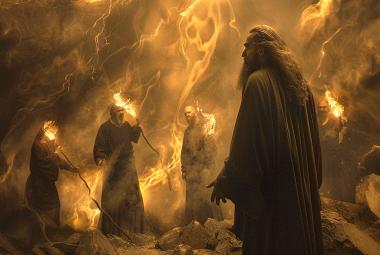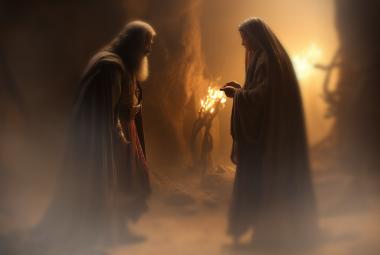This month we celebrate Easter. Whoops! Why do we label our most holy holiday with its pagan obfuscation? It is at this time that we celebrate the very Gospel itself: ''...how that Christ died for our sins according to the Scriptures; that He was buried; and that He rose again the third day according to the Scriptures.''1 Yet we still tend to label this most distinctive of celebrations with its reference to the pagan Queen of Heaven: Ishtar to the Babylonians, Astarte to the Semites, Aphrodite to the Greeks, and Ashtoreth in Hebrew, the mother of Tammuz, etc. And why do we still talk about rabbits that lay eggs? This, too, is an allusion to the Golden Egg of Astarte, a vestige of the pagan fertility cults of an ancient darkness.
We should join our Jewish friends and refer to this as Passover with its associated festivities: the Feast of Unleavened Bread and the Feast of First Fruits.2 The month of Nisan - re-designated ''the beginning of months''3 - includes the first three feasts (of the Mosaic seven) that anticipate the ''First Coming'' of the Messiah.
[It is the 7th month, Tishri, which includes the final three feasts that anticipate the Second Coming. Between these two seasons we find the Feast of Shavuot (the Feast of Pentecost), which highlights the intervening ecclesia, the Church.]
John the Baptist, when he first introduces Jesus publicly, twice highlights His prophetic role: ''Behold the Lamb of God which taketh away the sin of the world.''4 That's a very Jewish title.
The Strange Remedy
During the wilderness wanderings, on one of the many occasions that the children of Israel were murmuring against Gods provision, God sent deadly serpents as a judgment. In response to Moses prayer for the people, God instructed Moses to set up a bronze serpent on a pole, and everyone who looked upon it would live.5
A strange remedy. Why did God employ this peculiar method to provide for their healing and restoration? Prophecy is (strategic) pattern, not simply (tactical) predictions. It would be Jesus Himself who would explain this strange remedy during that evening visit of Nicodemus:
And as Moses lifted up the serpent in the wilderness, even so must the Son of man be lifted up: That whosoever believeth in him should not perish, but have eternal life.
John 3:14-15
In fact, this would occasion the most well-known verse in the Bible:
For God so loved the world, that he gave his only begotten Son, that whosoever believeth in him should not perish, but have everlasting life.
John 3:16
There are many graphic allusions to the Messiah in the Old Testament, and each one is singularly instructive.6 There were two occasions that Jesus was ''the rock'' that provided the living water.7 The first time Moses was instructed to smite the rock and it provided the needed water.8 The second time Moses didn't follow directions, and as a result he was denied entrance into the Promised Land!9 (If he had followed his instructions, these two occasions would have profiled the two comings of the Messiah!)
A ''Type'' of Christ
This emblem - a brass serpent raised on a pole - is distinctive in that the Lord Jesus Christ personally applied it to Himself. The more you examine it, the stranger it appears: brass was the Levitical symbol of judgment; brass was the metal that was associated with fire (as the brazen altar, etc.). The serpent was symbolic of sin, introduced in the Garden of Eden. This is a strange emblem, indeed, for the Savior of mankind:
For he hath made him to be sin for us, who knew no sin; that we might be made the righteousness of God in him.
2 Corinthians 5:21
And this is precisely what we celebrate during the Passover Season: His being raised up in our stead. Unfathomable. We may spend an eternity attempting to embrace the implications of this precious truth, and what it cost Him to purchase our eligibility to be in His presence.
[Our two briefing packs, The Agony of Love, and From Here to Eternity, attempt to probe some of the implications that we celebrate this season; and, The Romance of Redemption helps us understand Jesus role as our kinsman-redeemer. (Click the links for more info at our online store.)]
A Symbol of Healing
This incident during Israel's wilderness wanderings led to the Greek legends of Aesculapius, the god of healing, who was symbolized as a brass serpent on a pole, or cross. (It is amusing to notice that many medical professionals have adopted the caduceus, which includes two serpents entwined on a staff. What makes this amusing is that this was actually the symbol for Hermes, the god of commerce!)
This Passover Season, lets use the opportunity to seriously commit ourselves to embracing the most awesome and precious gift we can ever receive; a gift that has come to us at a price we cannot comprehend; a gift that establishes our eligibility throughout eternity. Baruch HaShem!
Notes:
- 1 Corinthians 15:1-4.
- See our Briefing Pack, The Feasts of Israel, for a review of the prophetic as well as commemorative implications.
- Exodus 12:2.
- John 1:29, 36.
- Numbers 21:4-9.
- Genesis 22; Hebrews 11:19; Hosea 11:1; Matthew 2:15. Each one is distinctive and instructive in method as well as content.
- 1 Corinthians 10:4.
- Exodus 17:6, 7.
- Numbers 20:8-13.





